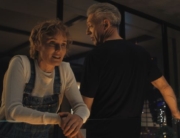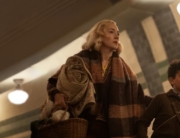The best films at the Toronto International Film Festival (TIFF) weren’t exactly brand-new discoveries. Many had just played the overlapping Venice Film Festival, where they had scored top prizes.
Typically, the two festivals share some 30 films every year. What is unusual this fall is that Venice, the world’s oldest film festival, bestowed its top accolade on a unique and well-crafted film with a populist bent, well-poised to jump out of the festival/art house loop: the classiest of B-movies, Guillermo del Toro’s The Shape of Water. There’s nothing else like it out right now. The winner of Best Screenplay went to writer/director Martin McDonagh for Three Billboards Outside of Ebbing, Missouri and Warwick Thornton’s The Sweet Country collected the Jury Honor. Both films went on to win audience choice awards at Toronto.
It’s not like this every year. Last year, Venice’s Golden Lion winner was the four-hour The Woman Who Left. Though acclaimed, it barely made a ripple internationally. In 2014, From Afar, the first Venezuelan film to win the top prize and one of the best films of that year, received a limited art-house release. (Keep in mind that 2014’s Birdman, though praised on the Lido, left Venice empty-handed.) So it’s rare when the favorites of the jury, this year headed by actress Annette Bening, and its Toronto reception are more or less in-sync.
The Shape of Water is a fairy tale for and about adults, with both a cast and characters on the other side of 40. The story would not have worked otherwise, given that the plot revolves around a group of outsiders who have been around the block a few times and who have been given a second chance, if not at redemption, then to at least break out of their respective molds and rebel, if just for a moment.
It’s not for nothing that the movie is set in the Baltimore of 1962, before the reforms of the civil rights movement had kicked in and when Cold War paranoia was at its apex. The pop culture is still left over from the Eisenhower era, before the British Invasion would storm the pop charts, displacing the likes of Andy Williams crooning “Theme from a Summer Place.” That and other pop standards are heard in the hip-to-be-square soundtrack. This movie may singlehandedly brings back the song “You’ll Never Know” and actresses Alice Faye and Betty Grable (both among the top female box office stars of the 1940s) to the attention of film buffs who aren’t addicted to Turner Classic Movies. Composer Alexandre Desplat complements the mid-20th century pop standards with an undulating and lilting waltz.
Like many of the better films at TIFF, Shape’s first frame indicates you’ll be in for something different (the same could be said of Paul Schrader’s First Reformed): the camera drifts along an underwater dwelling apartment, the furniture floating among the flotsam and jetsam as the narrator forewarns us of “the last days of a fair princess.” And she’s not your average Disney princess, but a “princess without a voice.”
That would be Eliza Esposito, who can’t speak; she’s played by Sally Hawkins in a dialogue-free performance that frees her from her go-to mannerisms. Not to be too cynical, but Eliza is the type of role that the Academy Awards love. (See Jane Wyman in Johnny Belinda or Patty Duke in The Miracle Worker.)
Eliza lives alone in an attic apartment above a fading downtown movie palace, the Orpheum, which has been reduced to playing sparsely-attended Cinemascope Biblical epics (which luckily, is one movie trend that has not come back). At 9 pm daily, Eliza wakes up and sets a timer, places it on the edge of the sink, takes a bath and, ah, pleasures herself (I did say this is an adult fairy tale). She then makes her lunch of boiled eggs and takes the bus to her job as a graveyard-shift janitor for a secretive governmental agency.
She lives across the hall from an unemployed advertising illustrator, Giles (Richard Perkins, never better as the alcoholic, gay sad-sack everyman who has lost his job because of, in not-so-subtle hints, his sexuality). Giles always has his black-and-white TV on as he works surrounded by cats, which is where he and Eliza catch old 20th Century Fox musicals. (Perhaps not coincidentally, Fox is releasing The Shape of Water internationally.)
During her nightly work routine, Eliza espies a creature trapped in a glass container. The manlike specimen could be a kissing cousin to the title star of The Creature from the Black Lagoon, though he’s blue-tinted, in great shape, taller than average, and has gills and scales covering his skin. (It’s Doug Jones underneath the getup.) He was found somewhere in South America, and rumor has it that he has healing powers.
During Eliza’s shift, she puts down her mop and, having the laboratory all to herself, leaves an offering of her hard-boiled eggs by the edge of the water tank for the water-bogged captive. She also brings along a portable record player and puts on a Benny Goodman LP, and begins communicating with the water-bogged observer through sign language, which he easily picks up. They are a lonely hearts club, membership numbering two.
Eliza works alongside chatterbox Zelda (Octavia Spencer), who understands sign language and becomes Eliza’s interpreter for the audience and the others in the governmental lair, explaining Eliza’s motivations and filling the holes in the plot. Spencer is among a select group of wry sidekicks. She could link arms with Eve Arden and Thelma Ritter, speaking of the 1940s or 1950s movies. Although it’s weird seeing Spencer play another cleaning lady, she’s nevertheless so good and brings warmth to the film’s chilly aqua-green-and-blue palette. What’s problematic is the portrayal of her jobless husband, who is also black and whom Zelda describes as lazy and wanting to be waited on hand and foot. As it turns out, he has a spine made of Jell-O, too.
Now cue the hissing: the top-level hot shot Strickland (Michael Shannon, in all his sliminess) wants to vivisect the alien specimen to understand its breathing system, supposedly for an advantage in the space race. (Left along with the creature, Strickland pointlessly and relentlessly tortures it with a cattle pod.) During one shift, Eliza overhears his plan and hatches a plot to save the life of the trapped kindred spirit, aided and abetted by Giles and Zelda. Her reasons go far beyond the humanitarian or platonic and toward the romantic, leading to perhaps the most straight-faced, upfront interspecies love scene on film.
However, Strickland’s not the only one keeping an eye on the secretive nocturnal goings-on in Baltimore: the Soviet Union also has an interest in what’s in the water tank, as well as a double agent lurking about. This is where the story line settles into a B-movie formula: characters somehow know crucial information, and coincidences and fortuitous timing abound.
Strickland is such an overwritten and one-note bureaucratic henchman that you can rest assured that every action he takes is for his own ego. Indeed, there is so little to reveal about him that the creature, his communication skills limited as they are, has more depth. Meanwhile, the audience learns too much about Strickland, who’s the essence of a self-hating man-in-charge.
The movie’s most fanciful sequence is a dance number involving Eliza and her love interest, even though the atmosphere throughout is fantastical (such as a scene in which Eliza and Giles watch a clip of Betty Grable dancing with a horse, which might be strangest thing you see in the film, which is saying something). A mash-up of lump-in-your-throat romance, espionage thrillers, and then some, The Shape of Water will especially be catnip for unapologetic movie musicals fans, maybe more so than for those drawn to movie monsters.
It’s been nearly 75 years since audiences left a screening humming 1943’s Hello, Frisco, Hello‘s Academy Award-winning “You’ll Never Know,” and here Renée Fleming croons that tune during the closing credits. It’s one of this nostalgic film’s many achievements. Another is the making a new kind of hybrid for grown-ups: a musical and female-centered Stranger Things by way of maniacal Mad Men.







Leave A Comment